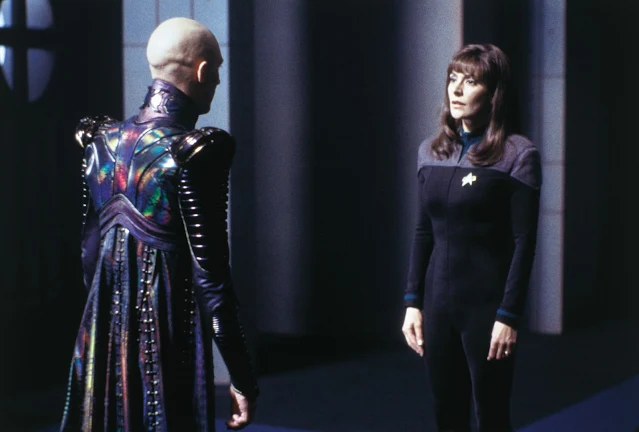A Dark Reflection: Deconstructing Star Trek: Nemesis
"Star Trek: Nemesis," the tenth film in the franchise and the final cinematic outing for the beloved cast of "Star Trek: The Next Generation," arrived in 2002 with the immense weight of concluding an era. Directed by Stuart Baird, the film attempted a darker, more action-oriented tone than the preceding *Insurrection*. However, it was met with a deeply divided response from fans and critics, becoming a controversial and bittersweet farewell. In this analysis, we'll dissect the intricate tapestry of this film—its plot, characters, themes, and its complicated place in the Star Trek universe.
Plot Synopsis: A Shadow on Romulus
"Nemesis" opens with the wedding of William Riker and Deanna Troi, but the celebration is cut short. The Enterprise-E, under the command of Captain Jean-Luc Picard, is dispatched on a diplomatic mission to Romulus following a coup. There, they discover the new Praetor is a man named Shinzon (a young Tom Hardy), who reveals a startling truth: he is a clone of Picard, created from a discarded Romulan plot to replace the captain with a deep-cover agent.
Raised in the brutal dilithium mines of the sister-world Remus by a subjugated race, Shinzon has seized control of the Romulan Empire with the backing of his fearsome Reman warriors. His flagship, the *Scimitar*, is a predator-like warbird with a perfect cloaking device and a devastating thalaron radiation weapon capable of wiping out all life on a planet. Shinzon’s plan is twofold: lure the Enterprise to him to cure his own rapid aging with Picard’s blood, and then use his superweapon to destroy the Federation, starting with Earth.
Character Analysis: Facing the Mirror
**Picard and Shinzon** are the heart of the film. Shinzon is Picard's dark reflection, his shadow self—what he could have become without the guiding principles of Starfleet. The conflict forces Picard to confront the haunting idea of his own potential for darkness, exploring the classic theme of nature versus nurture. Shinzon is not evil because he is a clone, but because his brutal upbringing on Remus has twisted him into a vessel of pure rage and pain.
The **Riker and Troi** subplot provides a sense of closure. Their marriage marks the end of an era for the Enterprise crew, and Riker’s long-awaited promotion to Captain of the USS *Titan* culminates his arc as Picard's loyal "Number One."
**Data's** journey reaches its poignant conclusion. The discovery of B-4, a simpler prototype of himself, forces Data to contemplate his own lineage and legacy. His ultimate sacrifice to destroy the *Scimitar* and save Picard is the ultimate expression of his humanity. By downloading his memories into B-4 beforehand, he achieves a form of immortality, a final, selfless act that proves he became more human than many biological beings.
Themes: Identity, Duality, and Sacrifice
"Nemesis" delves deeply into the theme of **identity**. The film questions whether destiny is determined by our genes (nature) or by our choices (nurture). The powerful motif of **duality and mirror imagery** threads through the entire narrative. The parallelism between Picard and Shinzon is a reflection of the paths individuals can take under different circumstances, contemplating the complexity of human nature and the multitude of possibilities that lie within every individual.
**Sacrifice** emerges as the film's most powerful motif. It is epitomized by Data's final act, a conscious choice that reflects the most fundamental aspect of his hard-won humanity: the capacity to put the needs of others before his own.
Action and Legacy
Director Stuart Baird, known for his work as an editor on action films, brought a kinetic and visceral style to the film. The final battle between the Enterprise and the Scimitar is one of the most brutal and intense in the franchise's history. The iconic moment where Picard orders the Enterprise to ram the enemy vessel is a thrilling highlight, showcasing a level of grit not often seen in *The Next Generation*.
Unfortunately, "Nemesis" faced an impossible challenge at the box office, opening against *The Lord of the Rings: The Two Towers*. Its underwhelming financial performance led to a nearly decade-long hiatus for Star Trek on the big screen, until the 2009 J.J. Abrams reboot. While divisive, the film's legacy has been re-examined in recent years, as its events—particularly the death of Data and the new path for Riker and Troi—serve as crucial backstory for the acclaimed *Star Trek: Picard* series.
Conclusion
*Star Trek: Nemesis*, while flawed, remains a valuable and significant installment. Its exploration of identity and choice aligns with the franchise's foundational themes, and it provides a dark, emotional, and action-packed farewell to a beloved crew. It stands as a reminder of the franchise's power to ask thought-provoking questions about our place in the cosmos, and within ourselves.













